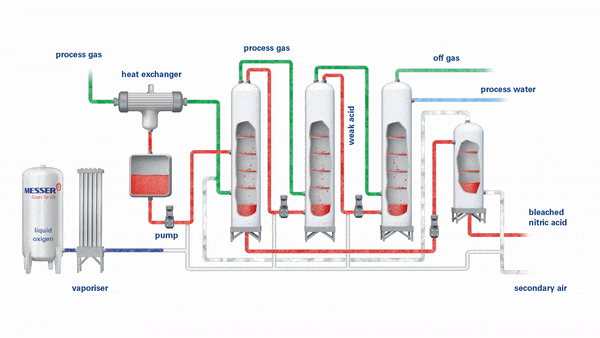
Gases for Life
GREEN PAGE
Oxygen in, NOx emissions down
By Editorial Team
In fertilizer production, nitric acid is an important precursor that is required in large quantities. Messer has developed a process that makes production more efficient while at the same time reducing nitrogen oxide emissions.

Gases for Life
GREEN PAGE
Oxygen in, NOx emissions down
By Editorial Team
In fertilizer production, nitric acid is an important precursor that is required in large quantities. Messer has developed a process that makes production more efficient while at the same time reducing nitrogen oxide emissions.
Some 60 million tonnes of nitric acid (HNO₃) are needed annually worldwide, 80 per cent of it in the fertilizer industry. Its production requires (atmospheric) oxygen, ammonia and water. These raw materials are transformed into the desired end product in a complex series of reactions. The fundamental process was developed by German chemist Wilhelm Ostwald back in 1902.
Simple vs. complex
The intermediate products include nitrogen oxides. These need to be reduced as much as possible since nitrogen oxide (NOx) emissions are subject to strict environmental regulations. Aspects of the nitric acid production process have been improved in detail over the years and facilities optimised accordingly. The main focus of these efforts has been on energy efficiency and reducing emissions. However, technical optimisation of facilities is a complex and cost-intensive process.
Messer has developed a system that facilitates considerable efficiency gains and reduces NOx emissions – without a large amount of technical complexity. “We achieve these objectives through the introduction of pure oxygen,” Dr Nina van Gellecom, Chemical Applications Expert at Messer, explains. “Certain reaction steps such as the oxidation of nitrous acid and dinitrogen tetroxide are significantly intensified with a much better end result. The crucial thing is to inject the gas at specific points in the process in accordance with a method developed and patented by Messer.”
Oxygen injection Process

Small investment, great benefit
The investment required is very manageable, particularly in relation to the return. This is demonstrated by the example of Azomures in Romania. The chemical company operates a plant in Tîrgu Mureş, which came into being back in the 1960s. Production efficiency was lower than that required by present-day standards, resulting in the release of excessive amounts of nitrogen oxides. In order to keep these emissions within the limits, the plant regularly had to be operated at reduced capacity or shut down altogether over longer periods in the warm summer months.
With the oxygen injection system installed by Messer, NOx emissions were reduced from 220 ppm to 20 ppm (ppm = parts per million) during testing. The emission limit within the EU is generally 90 ppm. Absorption of the nitrous oxides in the DeNOx unit – where some of these gases are converted to harmless nitrogen – was significantly improved. The supply of ammonia, which is required for reduction, decreased by 50 kilograms per hour at this point. At the same time, output increased by 260 kilograms per hour. This gain has been further increased through longer uptimes: since the plant now complies with the strict EU regulations on NOx emissions in warm weather as well, it can operate at full capacity during the summer months.
